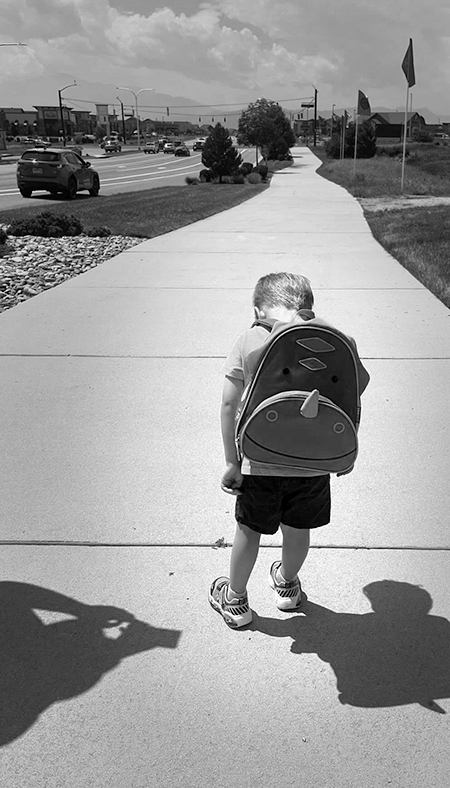The O.U.R. Children’s Safety Project
Behavior is Communication
By Allison Cunningham, AuD, Colorado H&V
Previously, when I’ve written for the Hands & Voices communicator, I focused on sharing my perspective as a hard of hearing professional. Apart from audiology and supporting families in their journey with their deaf/hard of hearing children, my biggest passion is studying and sharing trauma-informed/responsive approaches to supporting deaf/hard of hearing children and their families. Understanding the impact of trauma and/or toxic stress on child development, family systems, outcomes and even day-to-day interactions with families can be very beneficial. Perhaps one of the biggest lessons trauma responsive care offers is the understanding that all behavior is communication.

I was personally reminded of this lesson this past year. About a year ago, my newly three-year-old son was exhibiting increasingly challenging behaviors. My easygoing kid suddenly resisted any transitions: to school, to home, to the bathroom, even transitions to fun activities. Any attempts to set a boundary would escalate quickly and almost violently. He would even get himself out of the carseat while we were driving. We felt like we had to walk on eggshells around him. We never knew what would set him off.
Initially, I chalked it up to typical three-year-old behavior. Many three-year-olds struggle with transitions, are defiant and exude seemingly extreme and erratic behavior that don’t seem proportional to the demand being asked of them. However, my husband and I were struggling with how to support our son, so we enrolled him in occupational therapy. The occupational therapist quickly identified decreased emotional regulation and sensory processing issues. To my brain, with my knowledge of how children who are adopted (even from birth), are at higher risk for trauma, that made sense.
He was communicating with us in the only way he could: through his behavior.
Despite several sessions with the OT, trying different parenting approaches, his behaviors only escalated. He became self-injurious and would often attempt to harm both my husband and me, but especially me. My husband and I often had scratches and scabs on our faces and hands. At school, where he previously was never labeled a “behavior problem”, we were suddenly getting incident reports of him hitting, pinching, and kicking children. This went on for months.
Despite my knowledge and background, and access to resources at work, I had never felt so helpless. I felt like I was failing my child. The OT recommended hippotherapy. Hippotherapy is receiving therapy (speech, occupational or physical) while on horseback. It utilizes the natural gait of the horse to provide motor and sensory input. That rhythm can be especially conducive to bringing a person into a more regulated state while receiving therapy services. Just like you can’t teach a drowning child to swim (safety first), you can’t reason with a child in panic mode, so regulation has to come first. The week we started hippotherapy was the same week my son finally offered an understanding of what was happening to him.
My son told me that his teacher at school was hurting him. The same teacher he’s had since he turned three. Behavior is communication.
We believed him. I knew that the rare child who does report abuse has to tell an adult an average of seven times before action is taken. We did not wait to learn more. We quickly moved him to a new school. The change in environment, paired with several months of hippotherapy, got my son to a place where he finally felt safe in his body. He bloomed. He almost immediately stopped hurting himself, my husband, and me. He became more willing to try new things. He started making friends at school. He transitions so much easier. His tolerance for any sort of discomfort has increased significantly. His little body stopped being in fight or flight.
Lessons Learned
Behavior is communication. I’m heartbroken it took us months to figure out what my son had been trying to tell us. Hindsight is 20/20. Now I can see that he had a sudden change of behaviors in a new situation that were escalating. Those were my warning signs from a child not yet able to describe what was happening to him. Looking back, I also realize another barrier was the story I told myself about my son. I knew the statistics of adoptees and the prevalence of behaviors related to trauma. I made assumptions that his behavior wasn’t due to a new circumstance. I couldn’t see what was happening right in front of us.
When a child is identified as having a difference, parents are often provided information regarding expected outcomes. A story begins. Biases are honed and assumptions can form. It’s easy to attempt to fit our child’s development, their behaviors, their ‘isms’ into the label our children are given. But it’s not their whole story. Our children are always telling us so much. We just need to listen and see what their behavior is telling us. ~
H&V Communicator – Winter 2024/25